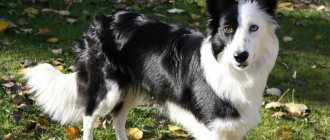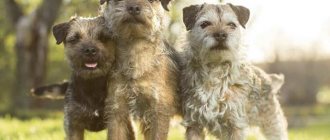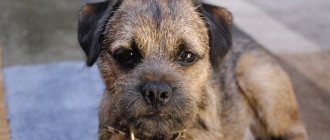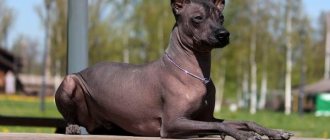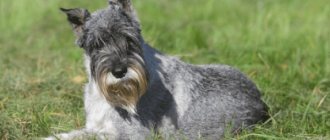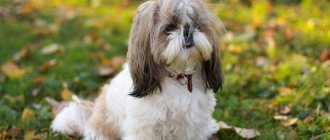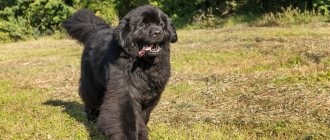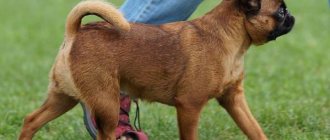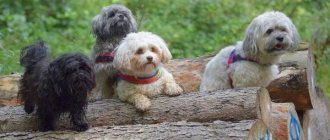| Origin: | Great Britain |
| Usage: | herding dog |
| Color: | black and white, red, sable, etc. |
| Dimensions: | height 47-53 cm, weight 15-22 kg |
| Lifespan: | 14-16 years old |
The border collie is one of the smartest dog breeds in the world. This is an amazing animal that has an almost human mind and the ability to feel the mood of its owner. The article provides basic information about the breed - external features, nuances of character, maintenance and upbringing.
Breed standard
The Border Collie standard describes the dog as graceful, harmonious, but at the same time strong and athletic. Animals with an excessively rough build or too shaggy coat are not welcome.
The document shows the optimal sizes of a border collie:
- the ideal height of a border collie for males is 53 cm, for females – a few cm less (47-52 cm);
- The weight of the animal is proportional to its height. Usually it ranges from 15-22 kg.
The animal's movements are free and graceful. When running, the dog raises its paws minimally - it seems as if it is sneaking at great speed. Representatives of the breed are excellent jumpers - they easily overcome obstacles that are several times higher than their own height.
| Official description of the breed (FCI standard No. 297): | |
| Become | Breed characteristics |
| Head | Wide, proportional to the body. The distance from the stop to the occipital protuberance is equal to the distance from the stop to the tip of the nose. The stop is clearly visible. |
| Muzzle | Medium length, wedge-shaped. |
| Nose | The nostrils are wide. The lobe is black; in animals of blue color it is gray. If the Border Collie dog has a liver or chocolate color, then brown pigmentation is allowed. |
| Jaws | Powerful, set in a scissor bite. |
| Eyes | Almond-shaped, widely set. The color of the iris is brown. The merle Border Collie may have a blue tint. The look is attentive, thoughtful, calm. This feature is reflected in any photograph. |
| Ears | Medium, rather dense, standing or semi-hanging. They are located at a considerable distance from each other. |
| Neck | Long, athletic, graceful. Smoothly expands as it approaches the body. |
| Torso | Stretched format - length greater than height. The chest is powerful, the muscles on the back are well developed. |
| Tail | It is medium in size, covered with thick fur, reminiscent of a fox. In a relaxed state it is lowered down; when working, the animal lifts it up, but never throws it over its back. |
| Limbs | Arranged in parallel. The paws are rounded, compact, the toes are tucked, the claws are small and very strong. |
Representatives of the breed have a dense coat with a thick undercoat that protects against temperature changes. Thanks to it, the animal can work in almost any weather conditions. The breed is divided into 2 varieties:
- smooth-haired;
- long-haired
Animals of the latter species have a mane, “pants” and a tassel on the tail. The fur on the head, ears, and paws is short and straight. Any non-compliance with the standard is considered a deficiency. Its severity is considered in accordance with the degree of impact on the health and performance of the animal.
What a border collie looks like, according to the standard, can be seen in the photograph.
Reproduction and lifespan
In order for the breeder to receive healthy puppies, he must select for mating adult males and females who have reached the age of sexual maturity - 2 years. It is strictly not recommended to breed younger dogs.
Ideal conditions for breeding are a nursery in which both “parents” know each other well from childhood. On what day of heat is it best to breed dogs? At 3 or 4. During this period, it is important to monitor the well-being of the bitch. She should not be overly aggressive, but if her mood is difficult to call good, it is better to postpone the mating.
Pregnancy in a Border Collie lasts about 70 days. During one birth, a bitch can give birth to 10-12 puppies, but more often fewer are born, no more than 6-7. These beautiful dogs live a long time, from 14 to 16 years.
Colors
The FCI breed standard allows for a variety of border collie colors, since the selection process focused on the working qualities of the animals, and not on their appearance. However, in none of the options is white the main color.
The classic color is black and white. The light shade predominates on the face, chest, belly, limbs, and tail. The dog may be spotted: there are small specks on the white areas, which appear a few days after birth
. The following colors are also common:
- red (chocolate, brown, liver);
- tan (shades from pale beige to dark red);
- gray (smoky);
- sable;
- ginger.
There is a tricolor color - combination:
- white;
- any other color (black, blue, brown, etc.);
- tan (shade from light beige to deep red) under the eyes, on the cheekbones and limbs.
Solid black color is not typical for the breed.
The marbled border collie looks beautiful and original: photos of these animals immediately catch your eye. Such pets often have heterochromia, which gives them even more charm. However, it is undesirable to cross two merle-colored dogs - the puppies are usually born dead, and if they survive, they have many congenital pathologies.
Merle Border Collies come in a variety of shades. The dog can be red, blue, red, sable, etc. The body of the animal is covered with richly pigmented or pale spots of varying sizes.
Also, all of these types may contain tan. Then the color will be correctly called, for example, marbled sable and tan. Puppies obtained from chocolate and blue individuals are lilac colored, a very rare color that is a mixture of brown and blue. Sometimes this color is called Isabella.
Are you here:
Library — Articles — Collie breeding by color
Site map
Collie breeding by color
The FCI and Kennel Club standard allows 3 colors - red and white, tricolor and harlequin. In the future, it is important for us to understand these things. The red and white color is not a white dog with large red spots, it is genetically a sable dog. The tricolor is not black and white with red, and not white with black and red - it is a black and tan dog. Marble is not gray, it is black and tan with a marble pattern. All three colors are accompanied by white markings. The main color (sable, black and white with merle pattern) is inherited separately and independently of the white markings. Let's take a short dive into the basics of genetics. Certain genes are responsible for the manifestation of traits (in our case, color). A gene is a fragment of a chromosome responsible for the formation of one protein (trait). Thus, one gene - one trait; but the opposite is far from necessary - one trait can be caused by the work of more than one gene. A linear region of a chromosome occupied by one gene is called a locus. You probably remember from your school course that in any somatic cell of any dog of any breed there are 39 pairs of chromosomes. L. Pasechnik makes a very apt comparison of a paired chromosome with a train. “The passengers of this train (genes) travel in 2-seater compartments (loci). The mother places her representative in one of the empty seats on the train, and the father takes the second seat. Unlike our trains, where passengers languish from boredom and idleness, genes work hard. Each of them is aimed at performing a specific task, and if 2 like-minded people meet in a compartment ( homozygosity for the trait
), then there can be no disagreement about how and what to paint.
What if there are 2 different genes ( heterozygosity
)?
The gene that works is the one that is more important, or, as it is also called, the dominant gene. And the weak, subordinate (recessive) quietly dozes and waits with hope for the moment when there will be a transfer to a new train and, perhaps, there he will meet a kindred spirit or at least an even weaker (recessive) rival, and then he will be able to show his full potential. talent." Not all loci and their genes have been identified in dogs. Most publications devoted to canine genetics talk about 11 loci. For us, three are of greatest interest
: A
,
M
and
S.
Locus A
(
a
gouti, agouti) contains 5 gene variants (5 alleles).
Let's briefly look at the full set of alleles for this locus: Ау
(
y
ellow, sable - collie, sheltie) >
aw
(
w
ild, zoned - wolf, German shepherd) >
asa
(
sa
ddle, sable - n/o, Airedale terrier) >
at
(
t
an, tan - Doberman, collie) >
a
(black - n/o, sheltie).
For our breed, only 2 of them are interesting: Ay
and
at
.
Dominance order: Ay
>
at
.
So, we have some abstract sable collie with Ay color. But we remember that there must be two artists on the train (this is biology), so our sable dog can be either AuAu
, or
АуAt
.
The first case, AuAu
, is
a sable dog that is homozygous for Au
, or
“without the black gene
.
Typically, but not necessarily, these dogs have a brighter appearance and minimal blackening on the body and head. They are often called red, emphasizing the brightness of the color, but this is only a popular name, in other words. genetics is wrong. It is correct to call them sable. I myself sometimes call them yellow :). We have two sable partners: male AuAu
and female
AuAu
.
During fertilization, the paternal body separates gametes (sex cells) of only one type: Au
,
Au
, and the maternal body also separates only one type:
Au
,
Au
.
Then these parent gametes fuse in pairs and give a “new” genotype - AuAy
.
True, in our case there is no novelty - all the descendants are only AuAu
, i.e. homozygous sable dogs. Novelty lies only in the birth of a new organism
homozygous sable dogs. Novelty lies only in the birth of a new organism
| Father AyAy , produces gametes | ||
| Mother AyAy , produces gametes | AyAy | AyAy |
| AyAy | AyAy | |
Thus, from two sable homozygous dogs we can only get sable puppies, because parents do not carry any alleles other than Au
.
IMPORTANT!
If not a single black (tri-color) puppy was born from a given couple, this, however, does not automatically mean that the parents are 100% homozygous.
If you do not know the genotype of your parents for sure, you cannot be completely sure that the parents are homozygous for Au
.
Full confidence in this can be given either by gene analysis for locus A
(for carriage of
at
), or by analyzing mating with a black partner. We won’t go into the first one now, but we’ll come to the second one later.
The second possible genetic state of sable color in our breed is Ayat
, or
a sable dog, heterozygous for Au
, or
“with a black gene”
.
As a rule, but not necessarily, such dogs look more blackened and have a more pronounced “cap” on their heads. By the way, the “hat” is one of the characteristic features of the sable color, regardless of the dog’s genetic status. Let's say we have one partner who is homozygous for Au
:
AuAu
;
second heterozygous: Ayat
. Grid of possible results for this combination:
| Father AyAy , produces gametes | ||
| Mother Ayat , produces gametes | AyAy | AyAy |
| Ayat | Ayat | |
Thus, we again received all puppies of only sable color, but some of them will be non-black carriers, some will be carriers - the quantitative ratio is approximately 50% + 50%.
IMPORTANT!
never
operate in terms of “half the puppies will be like this, half like that.” Genetics is an exact science, all possible splits (percentages) were studied and described long before us, but this statistics only works correctly on large numbers. Dogs with their litters of 4-10 puppies cannot be classified as such large numbers, or, to put it correctly, a litter of 4-10 puppies is not a reliable sample. Therefore, it is inappropriate to talk/write about “half a litter” or “a quarter of a litter”. We can only talk about a theoretical, expected, probabilistic, percentage breakdown: “the expected split on this basis: ~ 25% like this, ~ 25% like this, ~ 50% like this.” The more puppies in the litter, the higher the reliability of the sample, the greater the chance that the percentage will correctly “fall” on this litter. In a litter of 10 puppies or more, you can hope for more or less coincidence of the expected distribution with the actual one. Although there are very often cases when in small litters the distribution is close to the expected one, or completely coincides with it - but this is only a lucky coincidence, certainly very pleasant :).
Another possible combination of two sables is the mating of two heterozygous dogs, or “carriers of the black gene.” Let me remind you, this is Ayat
+
Ayat
.
| Father Ayat , produces gametes | ||
| Mother Ayat , produces gametes | AyAy | Ayat* |
| Ayat | atat | |
* if it’s easier for you to figure it out, you can write atAy
, this is absolutely the same color as
Ayat
, but it is more correct to put the more dominant allele first, i.e.
Ay
.
We are finally seeing the arrival of the black atat
.
Expected split in this mating: 25% homozygous sables, 50% heterozygous sables, 25% tricolors. Don't forget that this is just an expected split! We can expect the birth of tricolors, but in fact, out of 5 puppies, all will be born sables. By the way, it is quite possible that the expected black puppy was conceived, but for some reason died in utero at an early stage of development, “spoiling” the color statistics of the puppy. I repeat once again - if you breed two sable dogs with a genotype unknown to you for certain and get only sables from them, this does not mean that the parents are non-carriers of at
. But if from two sable dogs you get at least one black puppy in the first litter, this automatically means that both parents are carriers.
The second color in our breed, for which locus A is responsible, is tricolor
, or
tri-color
, or, as we learned at the very beginning - black and tan with white markings,
atat
. I refer to it as black from time to time in this article, for short.
Let's take the simplest combination: sable homozygous AuAy
+ tricolor
atat
:
| Father AyAy , produces gametes | ||
| Mother atat , produces gametes | Ayat | Ayat |
| Ayat | Ayat | |
All puppies from this combination will be heterozygous sable, even if there are 3 or 20 of them born 
Second possible combination of partners: sable heterozygous Ayat
+ tricolor
atat
:
| Father of Ayat , produces gametes Ay , at | ||
| Mother atat , produces gametes | Ayat | Ayat |
| atat | atat | |
Expected split: 50% sable heterozygotes, 50% tricolors. Third possible combination: knitting two tricolors. Here you don’t even need to draw a grid to understand why all the tricolors are born from such a combination.
IMPORTANT!
Literally a couple of times, but I heard the question: can the tricolor be carried by sable.
The attentive reader already knows the answer and the reason, but let’s still dwell on this a little. The tricolor has the genotype atat
.
As soon as a black dog acquires (at a Christmas market, or in a stock center, or maybe in a boutique) the sable color allele Ay
(“becomes a carrier of sable”) - this allele
Ay
, being more dominant, suppresses the allele
at
, coloring the dog in sable color. Not a trace remained of the tricolor. So, by definition, there cannot be tricolor bearers of sable.
So, possible states at locus A
, or sable and tricolor colors, we sorted it out.
Now let's turn our attention to the M
(
m
erle).
There are two alleles at this locus: M
and
m (APD 2022: according to the latest research, there are more alleles, but for the sake of understanding the inheritance of the marbled pattern, we will not go into that)
.
M
- dominant, responsible for the presence of a marble pattern;
m
- recessive, responsible for the absence of a marble pattern.
Interaction order: M
>
m
.
Possible combinations for this locus: mm
- homozygous for non-marbling, i.e.
non-marbled, dog; Mm
- heterozygous for marbling, i.e.
marbled, dog; MM
- homozygous for marbling, i.e.
double merle or double (white) merle. M
gene does not exist “by itself”; it must be superimposed on the main color, changing it. The main colors in kshk, as we know, are sable and tricolor. Let's start with the tricolor.
A tricolor dog whose genotype was suddenly affected by the combination Mm
, immediately becomes
atatMm
- black and tan with a marbled pattern, or, for short, marbled.
Let's take a short excursion into the essence of the “marbling” process. When the merle color gene influences the main color, the black pigment is “eaten up” in places, and gray areas appear in its place. This is how a marble pattern appears, i.e. alternation of pigmented and weakly pigmented areas. So a marbled dog is not a gray dog with black spots, but a black (black and tan) dog with gray spots :))). Although, as we know, the standard gives us the idea of a dog with a “gray background on which there are black spots.” The second possible interaction of locus A
with locus
M
is
atatmm
.
mm
is the absence of merle effect on the tricolor color, i.e. It's "just" a tricolor color.
IMPORTANT!
Much more often than the question of wearing the tricolor of sable, the question of wearing the tricolor of marble comes up. Again, the attentive reader will understand everything himself, but I’ll still explain it once again. The M gene clearly and mercilessly affects any existing primary color. As soon as a tricolor dog somewhere at a reasonable price acquires a bucket of liquid M, this paint, due to its activity (dominance), immediately floods the tricolor suit, making the dog marble. Thus, genetic carriage of marble is impossible. A dog's genotype is either completely marbled or completely non-marbled. There is no middle ground - “carrier of marble”.
Third possible interaction A
with
M
is
atatMM
, i.e.
tricolor dog with double marbles. Let me remind you that the single (heterozygous, Mm
) presence of the merle gene partially eats up the black pigment, making the dog black-gray or gray-black (depending on the ratio of gray to black).
When the second brush of the M
(
MM
) gene passes over this eaten paint, it eats what was already eaten before it, i.e. eats the gray color to white, and the existing black color to gray. What you will see is a nearly white dog with perhaps a few gray spots - a “double merle”. You will say: “beautiful!...”. Outwardly yes, but...
IMPORTANT!
Melanins (natural cellular pigments that determine color) are found not only in wool, but also in mucous membranes, the surface layer of the skin, the soft membrane of the brain, in the retina of the eyes, in the inner ear, etc., and they are not only responsible for pigmentation, but and participate in very important processes. In particular, “a layer of dark pigment protects the light-sensitive cells of the retina and improves the clarity of the resulting image by absorbing excess light and dampening glare reflected from the inner surface of the eye. In the inner ear, melanocytes are contained in the so-called stria vascularis, which produces endolymph that fills the cochlear cavity. In the absence or deficiency of melanin, the endolymph changes its ionic composition, which affects hearing acuity.” The “marble brush” touches not only the external pigment in the fur, but also the internal one, for example, the pigment of the retina or cochlea. As you understand, the “double marble brush” (MM) affects it doubly, creating serious problems with vision and hearing. In addition, dogs with double merles often have external visual deformities: abnormally small or completely absent eyes, their strange shape, etc. There is evidence that double merles (DM) have generally reduced viability, and many of them die at the embryonic stage. This is what may be hidden behind the external attractiveness of “white with gray spots.”
Now let's combine all these options. The first, the most, frankly speaking, healthy one is mating non-marble (tricolor) with marble:
| Father atatMm , produces gametes atM , atm | ||
| Mother atatmm , produces gametes | atatMm | atatmm |
| atatMm | atatmm | |
We expect 50% of the puppies will be merle, 50% non-marble.
Knitting marble with marble:
| Father atatMm , produces gametes | ||
| Mother atatМm , produces gametes | atatMM | atatМm |
| atatMm | atatmm | |
Expect 25% double merles, 50% merles, 25% tricolors. You may be lucky and no double merle puppies will be born from this combination. You may be very unlucky and have a few puppies that are white. But even if “only” one white puppy is born, you should not count on the fact that fortune will smile on you, and only your breeding double merle will be physically normal. To consolidate knowledge, double-merle mating mesh atatMM
+ double merle
atatMM
make up yourself, everything is simple here.
Mating non-marble atatmm
+ non-marble
atatmm
- I think everything is also clear, especially since we have already examined this case earlier, look carefully :))) Mating non-marble
atatmm
+ double-merle
atataMM
:
| Father atatMM , produces gametes atM , atM | ||
| Mother atatmm , produces gametes | atatMm | atatМm |
| atatMm | atatМm | |
All puppies will have a healthy merle color atatMm
. If you have no one else to breed your non-merle (tricolor) dog with other than a double merle, and the double merle you find is healthy and capable of reproducing, good luck! In conclusion of the marble section, let's dwell on two more important points. First: inheritance of the size, number, and location of spots is a random process, it is not predicted and cannot be selected. From parents with good black spots (not too big, not too blended) you can get a puppy that is almost completely black, with a pitiful amount of grey. Conversely, it is quite possible to get good black spots from parents that are too blackened.
If you have no one else to breed your non-merle (tricolor) dog with other than a double merle, and the double merle you find is healthy and capable of reproducing, good luck! In conclusion of the marble section, let's dwell on two more important points. First: inheritance of the size, number, and location of spots is a random process, it is not predicted and cannot be selected. From parents with good black spots (not too big, not too blended) you can get a puppy that is almost completely black, with a pitiful amount of grey. Conversely, it is quite possible to get good black spots from parents that are too blackened.
| Mother | Daughter |
| Mother | Daughter |
Second: the “background” color is inherited quite strongly! From parents with a bad background, slate or brownish, as a rule, you should not expect a miracle in the form of a good background in children. Quite often you hear that by supposedly mating two marbles you can get puppies with an excellent gray color. Of course you can! Provided that the gray color of the parents is good. If it is not good, the rabbit will not jump out of the hat.
And the last important locus for our breed is S
(
spotting
, white spotting).
We will not analyze in detail the inheritance of white spotting, because... even geneticists are still arguing about the existence of this locus, and the nature of the interaction of alleles in it is ambiguous. The following interaction scheme is conventionally accepted: S
(absence of white spots) >
si
(Irish spotting, or the usual “white genetics” than double merles. We will not dwell on them in detail, since we still do not breed this color and do not accepted. Let me just say that white collies with a colored head are dogs with a common base color (sable, tricolor or harlequin), the predominant part of the body of which is occupied by “overgrown” white markings.
White collies
Now let’s take a closer look at such a non-standard color as sable-marble (SM). For some reason, we generally believe that the SM color should look like an ordinary gray marble, but with a rusty coating. Probably because few people have seen this color in person and because people do not understand the essence of “marbling”. Don’t forget that in the case of marbling a sable, the base color is sable, not tricolor, so a SM dog, by definition, cannot have gray
For some reason, we generally believe that the SM color should look like an ordinary gray marble, but with a rusty coating. Probably because few people have seen this color in person and because people do not understand the essence of “marbling”. Don’t forget that in the case of marbling a sable, the base color is sable, not tricolor, so a SM dog, by definition, cannot have gray
spots! The merle gene brightens red pigment worse than black, so in a SM dog the contrast between the non-marbled areas and the marred ones is much less noticeable. In Sheltie and Collie dogs, this contrast can sometimes be seen only in small puppies with short hair.
Sable merle collies
So, if we marble a tricolor dog, we get a tricolor dog with gray marbled spots. If it is sable, then we get a sable dog with creamy spots and, sometimes, blue eyes. This is the best case scenario. In the worst case scenario, a SM dog may have both brown eyes and a small cream spot somewhere behind the ear or on the tail. Why "at worst"? Because without gene analysis for the M
you will not be able to tell for sure whether this dog is a “normal” sable or whether it is a SM. Below I will return to this issue again. In the previous sections we “knitted” sable-sable, sable-tricolor, tricolor-tricolor, tricolor-marble, marble-marble. Now let's do the same with sable and marble. I would like to note that I do not see an urgent need to carry out such matings, but I also do not see anything terrible in them. The puppies do not have health pathologies, there is no direct ban on such matings (at least in many countries and here), so...
Homozygous sable AyAymm
+ marble
atatMm
:
| Father of AyAymm , produces gametes Aym , Aym | ||
| Mother atatMm , produces gametes | AyatMm | Ay atМm |
| Ayatmm | Ay atmm | |
Result: 50% AyatMm
- sable-merle carriers of the tricolor, 50%
Ayatmm
- sable carriers of the tricolor, the most common heterozygous sable.
Heterozygous sable Ayatmm
+ marble
atatMm
:
| Father Ay atmm , produces gametes Aym , atm | ||
| Mother atatMm , produces gametes | AyatMm | Ay atmm |
| atatMm | atatmm | |
Result: 25% AyatMm
- sable-merle bearers of tricolor, 25%
atatMm
- ordinary merle, 25%
Ayatmm
- ordinary heterozygous sable, 25%
atatmm
- tricolor. I don’t see any practical sense at all in the first mating. In the second, you can at least count on the birth of tricolors and marbles. From this second litter, further breeding of all sable puppies is not recommended. As we already know, it is not always possible to say unambiguously whether a given sable puppy is truly sable or whether it is SM. Accordingly, we cannot know for sure what wonderful range of colors may be born from him in the future. More precisely, we can well know by drawing a simple table of gametes. If desired, of course, we can do a genetic test for the M locus. Such matings are usually carried out either out of oversight, or still pursue some specific goal. For example, when the number of breeding sires is very limited. Or when there is some important breeding idea (type, blood, temperament, health).
I don’t see any practical sense at all in the first mating. In the second, you can at least count on the birth of tricolors and marbles. From this second litter, further breeding of all sable puppies is not recommended. As we already know, it is not always possible to say unambiguously whether a given sable puppy is truly sable or whether it is SM. Accordingly, we cannot know for sure what wonderful range of colors may be born from him in the future. More precisely, we can well know by drawing a simple table of gametes. If desired, of course, we can do a genetic test for the M locus. Such matings are usually carried out either out of oversight, or still pursue some specific goal. For example, when the number of breeding sires is very limited. Or when there is some important breeding idea (type, blood, temperament, health).
IMPORTANT!
For some reason, we have a widespread opinion that mating a sable with a merle worsens the background quality of the resulting blue merle puppies, or that the bad background will be passed on “in a latent form” to further descendants. This is complete nonsense. Locus A genes have absolutely no effect on marbling production. The reason for dirty merle in SM should be sought in the initially bad, dirty merle of the merle parent, and not at all in the sable color of the sable parent. We have already discussed this with you in the section on merle coloring: a bad background will not produce a good background.
You can practice some more and “breed”, for example, a homo- and heterozygous sable with a double merle. Or two heterozygous sable-merle dogs :))) For now, let's move on to the final part: I would like to make a brief overview of other color loci.
—Locus B
(
b
rown, brown).
B
(black pigment)
> b
(brown pigment - Newfoundland, Doberman).
In our breed all dogs are BB
.
From time to time there are dogs with non-ideal black color, for example brownish (brownish), but the reason should be sought either in external factors (summer sunburn) or in the work of genes not related to the B
.
Sometimes there is an opinion that dogs with a brown tricolor are possible carriers of the brown (chocolate) color, Bb
.
I think it is easy to guess that if this were true, then from time to time we would get chocolate (brown) and tan dogs, like brown Dobermans - bb
.
— Locus E
(
extension
, distribution).
E m
(mask distribution of black pigment, mask) >
E
(normal distribution of black pigment) >
e
(prohibition of distribution of black pigment, its complete absence, red color).
All collies are HER
.
— Locus K
(blac
k
, black).
K
(solid black/brown) >
Kbr
(brindle) >
k
(normal distribution of black pigment).
All collies are kk
- they do not have brindle, and the tan of tricolors is not filled with solid black.
— Locus C
(
color
, influence on the intensity of red pigment).
C
(bright red) >
ch
(pale red) >
cl
(cream, almost white).
There is still no clear opinion on this locus. In our breed, dogs with good or sufficient red color are most often found (in both tricolors and sables), so our genotypes are most likely CC
,
CC h
,
chch
(in dogs with a very pale color).
— Locus D
(
dilute
, dilution).
D
(intensive coat coloring) >
d
(weakened).
Only affects black/brown pigment and does not affect red pigment. Collies are DD
.
An example of a dilute color is blue and tan (weakened black and white) and isabella (weakened brown) in Dobermanns and Russian Toys. — Locus G
(
g
raying, progressive graying).
G
(grey) >
g
(no grey).
Presented in Kerry Blue Terriers and Yorkies in the form of overcolored fur. In our breed gg
.
Not to be confused with age-related graying! — Locus T
(
ticking
, specks, small pigment spots on white areas).
T
(speckled) >
t
(no speckled). In our breed, of course, dogs can have genotypes
In our breed, of course, dogs can have genotypes
TT
,
Tt
,
tt
.
Ticking (speckled)
—Locus R
(
r
oan, roan, alternation of colored and uncolored single hairs along the body).
R
(presence of roan) >
r
(absence).
Typical for drathaars and other hunting breeds. Collies probably have rr
.
A few words about genetic analysis. In our breed it may be interesting for locus A
when it is not known exactly whether the dog is a carrier of the tricolor or is free from it, can black puppies be expected.
Well, in “exotic” matings - analysis by the M
.
For those who are interested in the issues of inheritance of colors and others more deeply, I recommend reading the book by L. Pasechnik “Colors of Dogs. Genetic, biochemical and molecular biological aspects”, M. Sotskaya “Genetics of colors and coats of dogs” and Sheila Schmutz’s English-language resource “Genetics of Coat Color and Type in Dogs”, where you can learn about all the latest research and results in the field coat genetics (colors, length, texture) of dogs.
© P. Rudenko
. Photo by A. Zamyatin, Z. Sorokin, O. Shokhalevich and from the International Database of Collie Dogs.
Full or partial copying of article materials is possible only with written permission!
Character
Representatives of the breed have a friendly character. Animals are active, attentive and responsible. They are not characterized by malice or cowardice. Pets are distrustful of strangers, but do not show obvious aggression.
This is a dog of more than one owner - it loves all family members equally. The pet loves to accompany the owner everywhere, but does not impose himself. Animals make contact only when people need their attention.
All types of collies (Blue Lacy, Aussie, Sheltie, Shorthaired Collie, etc.) are highly trainable. However, according to British scientists, it is the border collie that is the smartest dog. Owners teach their pets incredible tricks. For example, walking on your front paws.
However, learning should be interesting. If the dog gets bored, he will pretend to be stupid, sick, or suddenly go deaf. This behavior must be stopped, otherwise it will develop into a bad habit.
The high intelligence of animals also gives rise to disadvantages of the breed. These dogs are cunning: they try to manipulate the owner, forcing him to do what is convenient for them. You should not react to such provocations. When the pet realizes that the trick was unsuccessful, it will become obedient again.
If it is difficult to train an animal on your own, you should use the services of a dog handler who knows the characteristics of this breed well.
The dog should not be left idle. If the owner does not use it for its intended purpose, then another job is found for the pet. For example, they do agility or Frisbee.
Kinds
Representatives of the breed are not classified by weight and height, but by coat length - yes. There are short-haired and long-haired Scottish Shepherds. Each of them is charming in its own way.
Animals from each group have 2 types of undercoat: upper and lower. The first one is much tougher than the second one. Long-haired Shepherds have a “mane” on their necks. They also have another cute feature - a bushy tail.
Socialization
Socialization of the puppy begins immediately after it arrives in the house. He is introduced to the outside world, other animals and people, and is taught not to be afraid of the noise of the big city. To prevent the baby from being mischievous, he is provided with a variety of toys. The more there are, the better. Hyperactive puppies require strict discipline.
The dog needs to satisfy not only the need for movement, but also to develop intellectually.
Character formation is completed at approximately six months. Until this time, it is still possible to correct some temperamental deficiencies. Retraining an adult animal will be much more difficult. If your pet does something wrong, just change your intonation to strict - he will quickly understand the mistake. You cannot use physical force - representatives of the breed are very vulnerable and sensitive to violence. Border Collies and children get along great. The pet especially likes to spend time with teenagers - after all, you can run with them and do active entertainment. A properly socialized dog gets along with other pets and does not conflict with its relatives.
Education and training
It is a common belief that smart dogs that are prone to making independent decisions do not need training. It is completely wrong. On the contrary, such animals especially need competent education!
But an inexperienced dog breeder will probably have a lot of difficulties with training a Scottish Shepherd. She is quite lazy and stubborn, so she often pretends to be weak and stupid. You can't believe this! It is important to interest the dog in learning, to instill in him a love of training. Then he will be a successful student.
How to do this? The classic way is to reward the animal for its efforts with a treat. This way he will understand that putting in a certain amount of effort entails joy from food, and therefore he will be motivated. The second piece of advice is to not allow classes to be boring. Encourage your dog with a humorous voice and an approving pat.
Advice! You are clearly raising your Border Collie incorrectly if he starts yawning after a short interaction with you. In this case, the training will have to be postponed, or try to stimulate the animal’s interest in learning.
We recommend starting to train your dog with simple commands, gradually increasing the load. This will prevent her from becoming stressed. A good training option is sports. Install low fences in the yard at a distance of 1.5 meters from each other. Each height is up to 60 cm.
Also install vertically small tubes perpendicular to the ground. First, the dog must jump over three barriers, and then run through the tubes in a serpentine line. These simple exercises increase her endurance and discipline. To prevent your dog from getting confused, put a collar on him and slowly lead him along the desired path.
He will remember it by the 3rd time and will run it correctly himself. Train your Shetland Sheepdog to be obedient in your home. She shouldn't play around and play dirty tricks. Every time she does something bad, raise your voice at her.
But, you should not hit your pet under any circumstances. Since representatives of this breed are very intelligent, they easily associate verbal reprimand from their owner with previously committed actions, and understand what they did wrong.
How to choose a puppy
Before buying a puppy, it is advisable to visit exhibitions and chat with other owners to learn everything about the breed. Then you should choose a nursery by studying reviews on the Internet. It is recommended to purchase pets from organizations registered with the RKF and having a good reputation.
A responsible breeder will be happy to answer your questions, tell you everything about keeping and feeding the puppies, and also point out the pros and cons of the border collie.
This active pet is not suitable for every person - homebodies should take a closer look at another breed.
It is also necessary to get to know the animal's parents. Good heredity guarantees the physical and mental health of Border Collie puppies.
Color
- Sable with white;
- Tricolor;
- Blue Merle;
- Mahogany.
After looking at photos of collies, you will fall in love with this breed. No matter the coat or color, the collie looks very attractive and beautiful.
Features of maintenance and care
This breed is best owned by owners of private houses. But with long-term walking, pets successfully live in an apartment. The animal cannot be chained or locked in an enclosure - this is not a guard dog. For full development, he needs regular physical and intellectual exercise. Keeping and caring for a pet does not have any specific features. The only caveat is excessive activity. You need to walk your dog a lot, otherwise it will develop bad habits.
Grooming
The long-haired collie is more difficult to care for - it needs to be brushed daily, otherwise the fur will become matted and lose its shine. Some owners trim the fur on their paws to prevent dirt from accumulating on them.
A smooth-haired dog requires less attention - it is enough to tidy up its coat a couple of times a week. But during seasonal molting you will have to do this every day.
. Pets' eyes and ears are cleaned regularly. If a dog walks on soft ground, its nails must be trimmed. Animals are bathed as they become dirty, but not more than once a month.
Walk
The Border Collie needs to move a lot, play, and communicate with its owner. Pets are walked 2 times a day for at least 1 hour.
With a lack of movement, the dog begins to play pranks and destroy everything in the apartment.
Feeding
The Border Collie breed is undemanding in food, however, due to its high mobility, the dog requires high-calorie and properly balanced food. The animal’s diet can consist of natural food or industrial feed of premium and super-premium classes. It is not recommended to mix both menus. You should not overfeed the animal - the large size of an adult dog and excess weight in combination with physical activity lead to the development of joint diseases.
Features of the diet
This breed of dog needs special attention to its diet. You cannot give food from a common table, and it is also unacceptable to overfeed the animal.
The most popular dog names in alphabetical order with recommendationsShar Pei - history of the breed, character traits, care and possible problems + 87 photos
American Bulldog - history of the breed, appearance, specifics and characteristics, care (100 photos + video)
If there are no allergic reactions, you can keep your pet on natural products.
Health
Representatives of the breed are strong and hardy dogs. How long a border collie lives depends on heredity and living conditions. With proper care, the life expectancy of animals is 15 years.
Diseases
In rare cases, dogs of this breed suffer from the following diseases:
- congenital deafness;
- epilepsy;
- malignant hyperthermia;
- retinal atrophy;
- osteochondrosis;
- hip dysplasia.
For preventive purposes, you should visit the veterinarian twice a year. A specialist will be able to identify the disease at a very early stage and take appropriate measures.
Vaccinations
Concern for the primary vaccination of puppies falls on the shoulders of the breeder. At approximately 2 months of age, dogs are vaccinated against the most common diseases:
- carnivore plague;
- infectious hepatitis;
- parvovirus enteritis;
- coronavirus;
- parainfluenza;
- leptospirosis;
- trichophytosis.
After 2-3 weeks, the vaccine is reintroduced. At 6 months they give a rabies injection. Adult border collies are revaccinated annually and treated for parasites every 3 months.
Possible diseases and methods of treating them
Herding dogs are known to have very good health. They are strong, resilient and agile, often spend time in the fresh air, and are neat, so they rarely suffer from viral diseases. But, the Border Collie, like other dog breeds, is prone to diseases of the hip joint, namely dysplasia. Only a doctor can relieve the symptoms of this disease in your pet.
Osteochondrosis is also often observed in these animals. Such a diagnosis can only be given to them in a medical setting, but in everyday life it is quite easy to recognize this disease: the dog becomes less mobile, its body acquires visible asymmetry. It is contraindicated to independently treat such serious diseases in a Scottish Shepherd. Trust your veterinarian.
Some Border Collies may also be allergic to parasites. That is why they should be systematically given medications for fleas and worms. Dogs whose bodies are not parasitized by such creatures live longer.
Mating
Allowed for mating:
- males over two years old;
- bitches after the start of the third heat.
Border collie dogs that are too young will not be able to bear full-fledged offspring.
Mating is carried out in the morning on an empty stomach. The “partners” are first introduced, otherwise the bitch will not let the male in.
Border Collies are free-bred, but young animals are better bred by hand. It is advisable to invite an experienced breeder who will supervise the process. The next day, re-pairing is scheduled to increase the likelihood of conception.
Bitches most often whelp on day 63, but the duration of pregnancy ranges from 56 to 72 days.
If a dog cannot give birth for a long time, you need to contact a specialist. a delay indicates the presence of pathologies. healthy animals produce 6-8 puppies in one litter.
Price
The chance of purchasing a crossbreed, that is, a mongrel, in this case is high, especially if you do not know the Border Coli breed standard. When choosing a puppy, it is important to pay attention to its color, coat type, eye color and other parameters. That is why we recommend purchasing from a nursery.
Russian breeders who professionally breed Scottish Shepherds sell healthy puppies from 25 to 50 thousand rubles. They keep in touch with the buyer for a long time, until the animal is completely stronger.
How much do border collie puppies cost?
The cost of puppies is determined by:
- title of parents;
- litter size;
- compliance of the animal with the accepted standard;
- purchasing power of people in a particular region.
How much does a border collie puppy cost:
- the cost of a pet class pet is 30-40 thousand rubles;
- price of a breed-class puppy – from 50 thousand rubles;
- for a show-class animal you will have to pay from 70 thousand rubles.
Private individuals sell puppies much cheaper - for 12-20 thousand rubles. However, an undocumented pet may have hereditary diseases or be a mixed breed.
Story
The history of the origin of the border collie is not known for certain. According to one version, the ancestors of modern dogs were companions of the Vikings, who raided settlements located on the Scottish coast. Curious dogs ran away from their owners and were welcomed into their homes by local residents. Over time, they spread over a wide area, along the border of England with Scotland.
The ancestors of Borders were crossed with shepherd dogs, representatives of hunting breeds, and were used as shepherd dogs. The climate of this area is very harsh. Forested rocks cannot be used for farming. Cattle breeders needed hardy, strong, dexterous dogs capable of leading a flock to pasture along a narrow mountain path without harming the livestock.
Initially, no one monitored the population, but gradually sheep farmers appreciated its working qualities. The best individuals began to be selected for selection based on working qualities and external data. The service abilities of pets began to be used not only in pastures, but also in other areas.
Today, the Border Collie breed is valued as a rescue dog, border guard, and guide dog for the visually impaired. Their phenomenal intellectual development makes them excellent companions, capable of supporting and carrying out a wide variety of tasks.
The description of the Scottish breed appeared several centuries after its appearance - only in 1881. Dogs were officially recognized in 1884. The standard was approved in 1915 thanks to James Reid.
